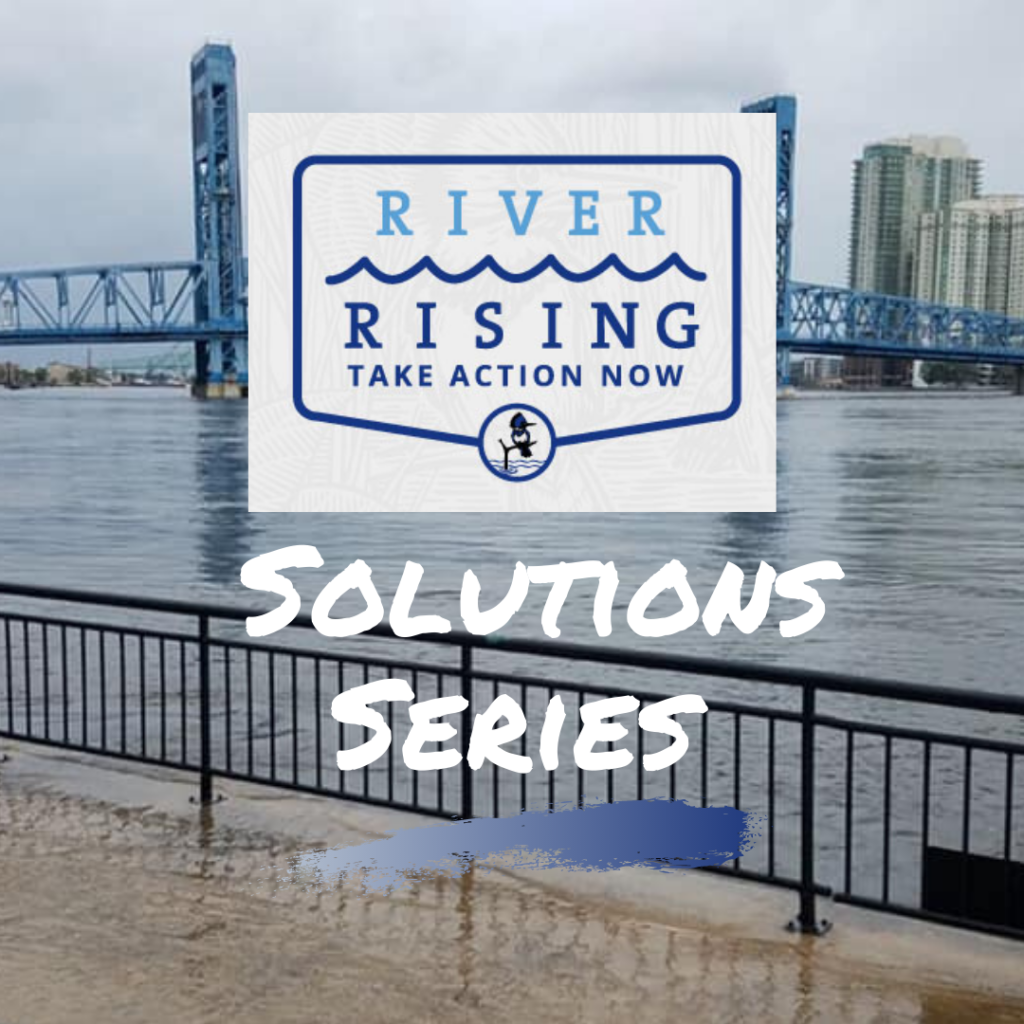Solutions Series

The St. Johns River resembles the Atlantic Ocean more than at any other time in its past: The currents are faster, the water is saltier and the tidal range can be more extreme.
The combined impacts from decades of dredging, sea level rise, and outdated infrastructure demand that we take action immediately to protect our river and our communities.
We need solutions.
Join St. Johns Riverkeeper staff as we discuss solutions to climate change and increasing water levels in the St. Johns with experts in the field. From parks to solar energy, we’ll talk about solutions across the board!
River Rising Episode 1 | Nate Monroe: As the Ocean Creeps In

Nate Monroe has covered city hall as a reporter and metro columnist at The Florida Times-Union since 2013. He previously worked at newspapers in the Florida Panhandle and South Louisiana. He graduated from Louisiana State University in 2010 and grew up outside New Orleans.
What was the impetus for writing As the ocean creeps in, with co-author Christopher Hong? What sparked your interest?
Like everyone, we were taken off guard by the historic flooding during Hurricane Irma. I was in downtown, Riverside and San Marco that day and saw floodwaters gushing into neighborhoods. It was shocking. This raised what seemed like a natural question to us: Does this have anything to do with the considerable changes we have made to the river the past 100 years?
What data did you find that most alarmed you, that you were the most surprised to find out?
I was surprised to see just how strong a correlation there is between dredging and increased storm surge. This is something the U.S. Army Corps acknowledges in its own environmental impact statement on the 47-foot dredging project – including that some portions of the river could see as much as 8 inches of increased storm surge. That is not an insignificant amount.
Can you describe the Superhighway to the Sea concept?
One of the experts we spoke to for this article helped us craft a useful way of thinking about this: Imagine riding a bike on a winding, bumpy trail through the woods. And now imagine riding a bike on a straight, freshly asphalted road. The road is easier, right? Something similar happens within waterways when we dredge them: We eliminate grass beds, rocks and underwater sand dunes – making the river smoother. And – in the case of the St. Johns River – we also straightened it. All of those changes provide less resistance to storm surge waves as they move upriver. A lot of really does boil down to simple friction.
Broken promises?
Jacksonville has spent much of the past 50 years spending money in a top-down way. There is an eagerness to subsidize corporate expansions with taxpayer money but a real reluctance to aggressively invest in simple neighborhood projects. The shipping companies ought to be the ones financing at least some of the dredging project because they are the ones who will benefit from this. Read more about the failure to spend money where it was promised.
Read what the Florida Times-Union Editorial Board has to say about the River’s Needs.
River Rising Episode 2 | Erik Olsen: Can a Wall Protect Us?

Erik Olsen received his academic training from the University of Florida. As the Principal Engineer for Olsen Associates, Inc., Mr. Olsen performs engineering, permitting and project management functions related to hydraulics, coastal processes, environmental impact assessment, shore stabilization, water and energy resources, and coastal management.
Can you describe who benefits from a wall, and who loses?
It is important to visualize the massive and continuous structure being proposed seaward of private and public properties. On the St Johns River, there are few areas where a protective sea wall is fiscally or physically warranted, none the less politically acceptable.
If one examines the so called sea wall projects conceptually envisioned for Charleston and Miami, it becomes clear that the massive structures being proposed are intended to protect certain urban areas threatened by existing and future storm related wave impacts under increased sea level scenarios. Neither project however, can well address the effects of flooding or the lack of drainage when the uplands are lower in elevation relative to the various water bodies due to the effects of SLR. Along the banks of the St Johns River private waterfront home owners would lose their view, their docks and basically the entire reason to live where they do.
What are the benefits of a seawall when it comes to drainage issues, and regular flooding concerns?
The type of sea walls being proposed will not serve to alleviate existing and expected drainage issues throughout most of the City core, the historical neighborhoods of San Marco, Riverside and other developed sections of the City bordering the St. Johns. They could actually impede the drainage infrastructure that currently exists from properly functioning.
Cost estimates for building a wall to protect Jacksonville, based on linear miles, are approximately $3.5 billion, or $3,990 per resident. Is that a fair estimate?
Any cost estimate made for the large scale application of a seawall in Jacksonville along the St. Johns are totally without merit, and pragmatically not worthy of any form of serious consideration. Most underestimate the actual cost of building a wall that considers the unique depth of the St. Johns in our downtown, more than 40 feet deep. Conversely, small scale isolated projects may be feasible ,but not capable of being hypothetically evaluated with respect to cost of application.
What actions would you like to see Jacksonville make that have a smaller price tag?
Beside holding forums and committees intended to educate the public and develop political agendas, the City needs to immediately adopt new resilient development standards for waterfront construction that are based upon realistic design storm parameters or guidelines and which provide for future sea level rise. Current standards in the City of Jacksonville (COJ) based upon FEMA Flood predictions are grossly inadequate and lead to the endangerment of new waterfront development. The most relevant prototype measures for consideration by the COJ are the design features being incorporated into the development of the FIS office building in Riverside. This action alone costs the COJ nothing but can save tens if not hundreds of millions of dollars in avoided damage to new development, subsidized by the taxpayers of Duval County.
River Rising Episode 3 | Karl Schrass: Can Parks Save Us?

Karl Schrass, Director of Conservation at the National Recreation and Parks Association has over seven years’ experience in the field of climate resilience. For the past five years he been leading nature-based climate resilience strategies in communities across the United States. Karl holds a MSc in Geography from the University of Bonn (Germany) and BA in Geography from the University of Delaware.
The National Recreation and Park Association brings a national focus to the far-reaching impact of successful local parks. Highlight a local park you’ve helped create.
We were the first investor in the Kathryn Johnston Memorial Park project in Atlanta. This project took an underutilized park space in West Atlanta that contained over 7,000 tons of polluted soil and was a source of sewage contaminated flooding and transformed it into an incredible neighborhood park and community asset that can capture 3.5 million gallons of stormwater while providing rich recreation amenities with a new playground, fitness equipment, and field that sits atop the detention basin.
Tell us about parks that are designed to hold flood waters.
The key to building a floodable park is two-fold. First, you want a natural area that reconnects the river to its floodplain. That means instead of constructing features that hold the water back, you restore the land-water connection and the critical near shore habitat that has been lost along so many of our waterways. Second, you want to be smart about what amenities you put in the new park and ensure that everything you install can either be easily removed and moved to higher ground during flooding events or can withstand the floodwaters and recover quickly. This is why many cities who have embraced floodable parks use them as greenways and trail systems.
How can parks reduce the flash flooding during regular storms that impact local neighborhoods?
This is where green stormwater infrastructure excels. By creating bioswales, rain gardens, and green roofs, as well as increasing tree canopy, you can help parks function like sponges – trapping the rain where it falls and slowly releasing it into the groundwater or the stormwater system. This helps to minimize and stretch out peak flow, which is when those flash flood events occur.
What can you tell us about waterfront parks, and how our shorelines serve as either green or grey infrastructure?
Protecting and restoring natural shorelines can actually help improve their resiliency to storms. Natural shorelines or restored, living shorelines allow that land-water connection to take place, which is beneficial both to the ecosystem and anyone who believes that people should have access to water in their community. When the shoreline is replaced with riprap or bulkheads, that connection is disrupted, and even though many people think that the shoreline is more protected, there is science from up and down the Atlantic coast that shows that natural shorelines are more resilient to storms and are able to naturally recover from extreme events.
In looking to the future, what trends are you seeing in communities looking at parks to serve as critical resilient infrastructure?
We’re seeing an increased recognition of parks and parks and recreation professionals as critical infrastructure and essential workers. A quality park provides a variety of health, environmental, social, and economic benefits to the surrounding community. As the stewards of over 11 million acres of “nearby nature” park and recreation professionals are crucial players when it comes to helping our communities embrace green infrastructure and nature-based approaches to resilience.
River Rising Episode 4 | Cory Rayburn: Is Nature the Next Big Thing in Green INfrastructure?

Cory Rayburn is the Watershed Manager for the City of Atlanta. He’s experienced in creating and implementing innovative programs that protect natural resources and promote sustainable development. Consensus builder with technical background in stormwater management, erosion and sedimentation control, land development, and civil engineering. Cory is the lead role in adopting and implementing Atlanta’s new Green Infrastructure standards for stormwater management.
Why is Atlanta a leader in innovative projects and investments in Stormwater infrastructure?
The City of Atlanta has embraced the use of green infrastructure on multiple fronts as a means of water quality improvement, flood reduction, and combined sewer capacity relief. Early adoption of runoff reduction standards for private development has led to over 6,000 sites installing green infrastructure practices such as bioretention, permeable pavement, and infiltration systems. On the planning level, the Department of Watershed Management’s Green Infrastructure Strategic Action Plan has provided a roadmap for integrating green infrastructure strategies into decision-making processes. Environmental Impact Bonds have been incorporated into the City’s funding efforts for implementing both natural and engineered green infrastructure within historically impacted watersheds. These efforts highlight Mayor Keisha Lance Bottoms’ commitment “to advancing green infrastructure that improves the quality of life and resilience of Atlanta’s communities.”
Check out the Storymap for the City of Atlanta’s Green Infrastructure projects.
River Rising Episode 5 | Angela demonbreun: the state of solar in fl

Angela DeMonbreun oversees Solar United Neighbors field programs in Florida, Texas, Arizona, and Colorado, and she serves as State Director for the Florida program. Angela is a fourth generation Floridian. Prior to joining Solar United Neighbors, Angela served as president of the League of Women Voters Jacksonville First Coast working to increase informed voter participation through education and advocacy. She continues to serve as their Environment Director.
When discussing resiliency, how does solar help communities to recover?
When the power goes out our safety and security are at risk. That is why our state government should make it easier for Sunshine State residents and communities to install solar plus battery storage systems. When the grid is down, solar and batteries can keep the power on so that our homes, businesses, critical emergency services (police, fire, EMS), and basic health infrastructure (hospitals, nursing homes, clinics, drinking water systems) can continue when we need them the most.
How much does solar from Florida utility customers’ rooftops contribute to Florida’s energy economy?
In 2018, solar power of all kinds constituted just under 1% of all energy generated in Florida. Customer-sited rooftop solar represents just one segment of the total solar market, which also includes community and utility-scale projects. In 2019, the Florida Public Service Commission reported that almost 60,000 Floridian households and businesses had gone solar, installing over 507 megawatts. That’s just over half a percent of all Florida’s electric customers. The Commission data also show that solar owners import more energy than they export back to the grid every year – meaning that even after adding solar, these customers continue to purchase electricity from the grid, similar to other energy conservation technologies. In terms of rooftop solar’s penetration on the grid, Florida ranks 26th in the country.
River Rising Episode 6 | Salome Garcia: Climate Justice

Salome Garcia is the Policy and Campaigns Manager for The CLEO Institute, a latinx led non-profit that drives climate action through community education and engagement. Before joining CLEO, Salome worked alongside Food and Water Watch, Oceana, and Miami Climate Alliance leading environmental policy advocacy work focusing on oil and gas development and climate equity. She has a graduate certificate in Climate Change and Health from Yale School of Public Health, a Bachelor’s degree in International Relations and Environmental Policy and is currently a doctoral candidate at FSU’s School of Law focusing on international climate law.
Can you describe what Intersectional Environmentalism is?
There is no climate justice without racial justice. This is the basic tenant of “intersectional environmentalism.” Intersectional environmentalism is an inclusive version of environmentalism that advocates for both the protection of people and the planet. It identifies the ways in which injustices happening to marginalized communities and the earth are interconnected. As policymakers take steps to ensure immediate relief and long-term recovery from the pandemic, it is imperative that they consider the inter-relatedness of the climate crisis, wealth inequality, racism, and ecological decline, which were in place long before COVID-19, and now risk being intensified. This is a time to be decisive in saving lives and bold in charting a path to a genuinely healthier and more equitable future through a just recovery. Read more from my article on the topic here.
River Rising Episode 7 | Chris Castro: Cities Solving Climate Change

Chris Castro, Director of Sustainability & Resilience for the City of Orlando as well as the Co-Chair of Smart Cities Initiative. Brittany Sellers, Sustainability Project Manager, focusing on Energy, Water, Transportation with the City of Orlando.
Learn more about the great work the City of Orlando is doing through its Community Action Plan with focus areas in Local Food Systems, Livability, Alternative Transportation, Zero Waste, Clean Water, Clean Energy, and Green Buildings.
How is Orlando focusing on Clean Water through its sustainability and resiliency community action strategy?
The City of Orlando is home to more than 100 lakes and 10% of the city’s area is made up of water. Many of Orlando’s lakes are publicly-accessible and provide recreational opportunities for fishing, boating and swimming. While Orlando has been a leader in successfully managing water resources, the projected increases in extreme heat, drought and extreme storm events still pose major long-term concerns to the overall water supply and water quality. Here are the goals we are working towards:
- Enhance Orlando’s reputation as “The City Beautiful” by promoting sustainable landscaping practices.
- Reduce gross potable water consumption per capita by 20%.
- Increase number of lakes meeting good water quality standard (Trophic State Index less than 61).
- Expand education and outreach efforts to increase understanding of how to manage water resources and pollution prevention.
- Ensure Orlando mitigates inland flooding during future extreme weather events.
River Rising Episode 8 | Karen Firehock: Trees as Resiliency

Karen Firehock, Executive Director of the Green Infrastructure Center, Inc. The Center maps, models and creates strategies to conserve or restore natural resources in both wild and urban landscapes to create more resilient communities. She has authored numerous green infrastructure books, case studies, videos and webinars and works across the U.S. She has worked on green infrastructure plans from Jacksonville to Miami Beach. Prior to GIC, she was a Senior Associate at the UVA Institute for Environmental Negotiation. She has a B.S. in Natural Resources Management from UMD and a M.P. Urban and Environmental Planning from UVA.
How do trees intercept water?
Trees capture water through rainfall as leaves intercept water and funnel that water down branches and the trunk. Some water flows down the trunk while other raindrops go through the branches (throughfall). The water moving through the branches to the soil are captured in the soil. Some of that water is pulled by the tree roots up into the tree and into the leaves where water can then evaporate. The leaf area of the tree’s leaves affect how much water can be captured. Trees that are more leafy intercept more water. Evergreen trees take up the most water! Although their leaves — needles — are small, there are so many of them that they capture even more water than a broad leaf tree. Large trees capture the most water generally (think about all the extra branches giving a large canopy and the large trunk. Water is able to move up from the roots of the tree through the tiny xylem vessels which maintain negative pressure. The water is then stored in the tree’s phloem until the tree needs it, usually in the morning, when it travels back to the xylem through cells called horizontal ray parenchyma cells, or simply ‘wood rays’. Water is pushed out of the tree’s leaves through the stomata pores which both helps with gas exchange and to cool the tree when needed. This process is called “transpiration.” Tree roots extend another half distance past the edge of the tree canopy. So even rain falling through the open sky to the ground can get captured by lateral tree roots and pulled up into the tree. And of course, some water is evaporated off of the tree directly such as when a short rainstorm on a hot day creates steamy air and water evaporates quickly. MORE TREES, MORE TREES, MORE TREES!
Learn more about Trees to Offset Water in Orange County and Trees to Offset Water in Duval County, reports created by Karen and the team at the GIC discussed in this episode.
River Rising Episode 9 | Aliki Moncrief: Voting to Fix Climate Change

River Rising Episode 10 | Lisa Chambers: Wetlands and Carbon Capture

River Rising Episode 11 | John Kiefer: Tributary Restoration and Rising Waters

River Rising Episode 12 | Marisa Aho: Houston Resilience and Recovery

Marissa Aho has served as Houston’s Chief Resilience Officer for Mayor Sylvester Turner since February 2019. In this role she leads the resilience-building efforts for the city’s resiliency strategy. Resilient Houston has 5 chapters, 18 goals and targets, and 62 actions that address, among many challenges, flooding, climate change, inequity, housing affordability, and improved mobility. She previously served as Los Angeles’ first Chief Resilience Officer beginning in 2015. She currently serves on the global steering committee for the Resilient Cities Network. She has a Bachelor of Arts degree in Political Science and Communications, Legal Institutions, Economics and Government from The American University in Washington D.C. and a Master of Planning degree from the University of Southern California.
Resilient Houston covers a lot of ground. It’s more than flooding and drainage. What other reports or strategies help to back up the Resilient Houston strategy?
Houston wanted a thorough Resiliency strategy and we worked to create this plan in just one year. However, it is not standalone. Much background came from work I had done as the first CRO for the City of Los Angeles. In addition we utilized expertise to create:
- Houston Resilience Assessment
- Climate Impact Assessment
- Living with Water Houston
- Incentives for Green Development Houston
Further, much work is also being done in response to Hurricane Harvey by the Chief Recovery Officer.
How does Houston support the structure of the Chief Resiliency Officer position?
Each department has a person that is responsible for Resiliency. When doing planning work or if I need to work across departments, I convene the Resiliency Officers together. We also meet regularly. This ensures that as Chief Resiliency Officer reporting directly to the Mayor, I am also working within departments without creating an overly burdensome workload for any individual.